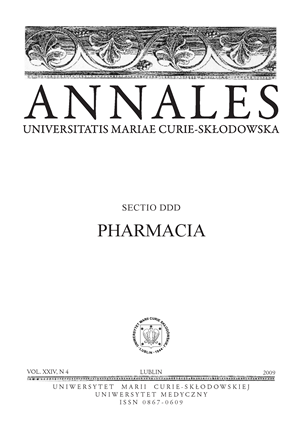Thin-layer chromatography of sugars in plant material
Abstract
In the present publication experiments were concentrated on elaborating a simple method of separation standards of monosaccharides and choosing the best practically applied method of derivation. Sugars and their alcohol derivatives were analyzed. Six methods of monosaccharides detection were tested. Two stationary phases with several eluents were investigated. The method was used to analyze hydrolyzed monosaccharides from Malvae arborae flos polysaccharides. The samples were hydrolyzed into monosaccharide units with an acidic reagent – sulfuric acid (VI). On silica stationary phase, galactose was identified in hydrolysate of one fraction of Malve arborae polysaccharides. Investigations of monosaccharides separation with the use of HPTLC-Diol stationary phases was conducted for the first time. The best separation was achieved with a mixture of 1-propanol and ethyl acetate as a mobile phase. In this chromatographic set glucose was identified.
References
1. Chen H. et al.: Antioxidant activities of different fractions of polysaccharide conjugates from green tea (Camellia Sinensis). Food Chem., 106, 559, 2008.
2. Dong O. et al.: Structural characterization of the water-extractable polysaccharides from Sophora subprostata roots. Carbohydrate Polymers, 54, 13, 2003.
3. Drozdova I. L, Bubenchikov R. A.: Composition and anti-inflammatory activity of polysaccharide complexes extracted from sweet violet and low mallow. Pharm. Chem. J., 4, 29,2005.
4. Dyeing Reagents for Thin Layer and Paper Chromatography, Reagents MERCK, Darmstadt 1980.
5. Hromadkova Z. et. al.: Comparision of classical and ultrasound-assisted extraction of polysaccharides from Salvia officinalis L. Ultrasonics Sonochem., 5, 163, 1999.
6. Jork H., Funk W., Fischer W., Wimmer H.: Thin-Layer Chromatography. Reagents and Detection Methods. VCH Publishers, Weinhein 1990.
7. Kolmünzer S.: Farmakognozja, Wyd. Lek. PZWL, Warszawa 2000.
8. Kurbanova A. D. et al.: Polysaccharides of saponin-bearing plants. Chem. Nat. Comp., 6, 608, 2002.
9. Opieńska-Blauth I., Smoczkiewiczowa A.: Vademecum chromatograficzne. PWN, Warszawa 1968.
10. Soczewiński E., Wójciak M., Pachowicz K.: Rapid thin layer chromatographic systems for the analysis of sugars. Chem Anal., 43, 823, 1998.
11. Strzelecka H. (ed.), Chemiczne metody badań roślinnych surowców leczniczych. PZWL, Warszawa 1987.
12. Tannin-Spitz T. et al.: Antioxidant activity of the polysaccharide of the red microalga Porphyridium sp. J. Appl. Phyco., 17, 215, 2005.
13. Waksmundzka-Hajnos M. (ed.): Thin Layer Chromatography in Phytochemistry. CRC Press, New York 2008.
14. Wang Q., Fang Y. J.: Analysis of sugars in traditional Chinese drugs. Chromatogr. B, 812, 309,2004.
15. Wang H., Ooi E. V., Ang P. O.: Antiviral polysaccharides isolated from Hong Kong brown seaweed Hydroclathrus clathratus. Sci. China Ser. C-Life Sci., 50, 611, 2007.
16. Xu B. et al.: Isolation and characterization of an anti-HSV polysaccharide from Prunella vulgaris. Chin. J. Chromatogr., 21, 410, 2003.
17. Yu R. et al.: Structural characterization and antioxidant activity of polysaccharide from the fruiting bodies of cultured Cordyceps militaris. Carbohydrate Polymers, 70, 430, 2007.
Downloads
Published
Issue
Section
License
Copyright (c) 2009 Authors

This work is licensed under a Creative Commons Attribution-NonCommercial-NoDerivatives 3.0 Unported License.


